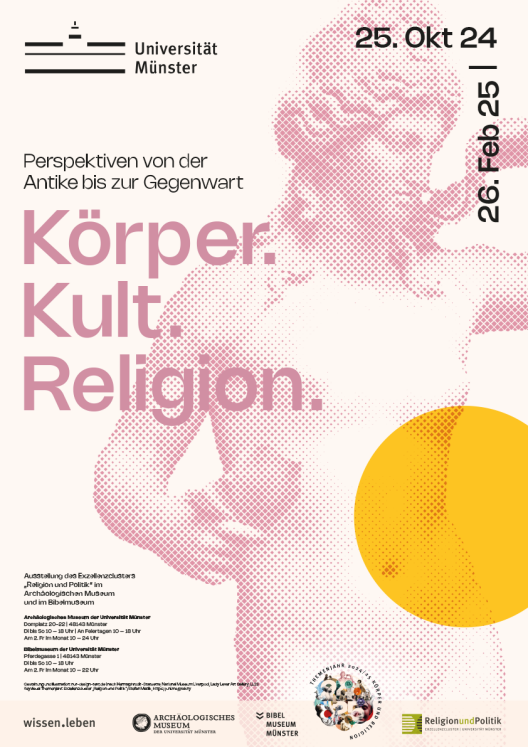Gender Roles? – On gender roles in the world's religions
Thematic field of the exhibition "Body. Cult. Religion."

Male and female are central, but not absolute categories of physicality, which are also religiously legitimised and defined, from which role attributions – social, reproductive and sexual – arise. In scholarship, a distinction is often made between the ‘biological’ gender on the one hand, i.e. the gender assigned to a person on the basis of physiological attributes, and social gender on the other hand, which refers to behavioural expectations that are associated with biological gender.
In all ancient communities of antiquity, in Judaism, Christianity and Islam, but also in Hinduism, Buddhism and Confucianism, there is a fundamental subordination of women to men. The second creation account in the Bible, for example, states that Eve was created from Adam‘s side and makes it clear that woman is subordinate to man. In the so-called tantric forms of Hindu and Buddhist-influenced religiosity that spread from India to Central and East Asia, gender polarity takes on a prominent symbolic significance, with the female often representing transcendent wisdom and the male its compassionate and skilful practical implementation – a view that is less familiar to European cultures.
Selected exhibits
The following texts are based on the exhibition catalogue:
Erhardt, S.; Graefe, J.; Lichtenberger, A.; Lohwasser, A.; Nieswandt, H.-H.; Strutwolf, H. (eds.): Body. Cult. Religion. Perspectives from Antiquity to the Present. Münster 2024. (only available in german)
Statuette of the Roman god Hermaphroditos from the 1st century AD. (Cat. no. 57)

© Lady Lever Art Gallery, Liverpool Hermaphroditos was the child of the Roman gods Hermes and Aphrodite and was worshipped as a god of marriage and fertility. According to ancient sources, he merged with a nymph, giving his body both female and male sexual characteristics. Real intersex people, i.e. people born with characteristics of more than one gender, are viewed both positively and negatively in ancient sources. (exc/fbu)
Terracotta of a naked woman (Cat. no. 52)

© Silvia Meier In the 2nd millennium BCE, terracotta figurines of naked women probably represented female fertility, highlighted by their voluptuous hips and thighs. Depicted holding their breasts, they were widespread in southwestern Iran. This terracotta figure was found in the Elamite capital of Susa. She is wearing an elaborately decorated diadem on her head, a necklace with pendants that falls to her breasts, three bracelets on each arm, and a bracelet around each ankle. Her eyes are larger than life and her mouth seems to be smiling slightly. The area around her breasts is highlighted by a decorative band, and the pubic triangle is defined by a pattern of peaks. The vertical edge between the navel and the decorative band around the breasts is a characteristic feature of this type of figure. (exc/pie)
Miniature from the manuscript ‘The Use of Animals’ (Cat. no. 69)

© The Morgan Library & Museum. MS M. 500, fol. 4v. Purchased by J. Pierpont The Persian manuscript on the use of animals (manāfiʿ al-hayawān) dates from the 13th century and is just one example of a whole series of similar works dealing with the possible pharmaceutical uses of various animals parts, but also with the use of human body parts. Particularly well known is a work of this title attributed to the physician ʿUbaydallāh Ibn Bakhtīshūʿ (11th century). Although the text deals primarily with the use of humans in general, the illustration clearly shows that the human body could at that time not be conceived and described in any other way than in the form of the bipolar sexes of man and woman. (exc/tst)
Statuette of the Great God’s Wife Ahmose-Nefertari from the 19th Dynasty (1213-1200 BCE) (Cat. no. 55)

© ÄMP Berlin Ahmose-Nefertari was the founder of the priestly office of ‘Great God’s Wife’ in ancient Egypt. The office embodies the ideal of the Egyptian queen as the earthly wife of the god Amun. The Great God’s Wives therefore symbolize the interweaving of the human and the divine, which was very important for the continuation of the Egyptian royal office. (exc/fbu)
‘Orthodox Eros’ photo series by Lea Golda Holterman (Cat. No. 65)

© Lea Golda Holterman The ‘Orthodox Eros’ series by Israeli photographer Lea Golda Holterman shows orchestrated portraits of young Jewish men. Holterman’s homoerotic photographs of ultra-orthodox boys combine sexuality with expressions of religious piety. This combination of body, sexuality and spirituality reflects the Jewish concept that affords the body and the soul a central place. The opinion of Jewish sages often differed from that of Christian cultures, where the view prevailed that the body is only the prison of the soul. Holterman’s photo series challenges and reflects on the myth of the ‘exile’ Jew, whom Jews and antisemites alike used to perceive as being passive and effeminate, castrated and sometimes also homosexual. (exc/tst)
Statuette of goddess Guanyin with child (Cat. no. 72)
© Übersee-Museum Bremen The statuette shows Guanyin, the Chinese version of the Bodhisattva Avalokiteśvara. In Buddhism, Bodhisattvas are revered as moral and socially-oriented beings who, through Buddhist teachings, release earthly souls from the cycle of reincarnation and thus from their suffering. In China, Guanyin was depicted androgynously after the spread of Buddhism, although female features often predominated. From the 12th century onwards, there have been almost exclusively female depictions, one of which, shown here, has prevailed: a Madonna-like figure with child (songzi Guanyin 送子 觀音; child-giving Guanyin). She gave women in particular a new figure that they could turn to with their concerns regarding childbirth and offspring. (exc/tst)

